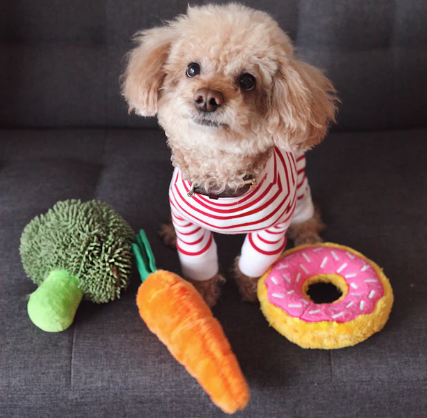
Puppy Food
Puppies grow up very quickly, so it’s important that they are supported throughout with a nutritious, healthy diet. At OlliePets we offer a huge range of delicious, healthy puppy foods, specially designed to be gentle on their immune system whilst your pet is still growing.
Obesity in dogs
Domesticated animals often feel like as much a part of the family as anyone else, but because of their lifestyle away from their natural environment, they can suffer from the somewhat human health issue of obesity. A study conducted in 2010 found that 59% of dogs in the UK were overweight or obese – a shocking figure for dog owners who want nothing but health for their companion.
How to check if your dog is overweight or obese
There are a few simple checks that you can do at home to find out if your dog is overweight:
- Check if you can see and feel the outline of your dog’s ribs – is there excess fat covering them?
- Look at your dog from above – can you see their waist?
- Look at your dog from the side – is their belly tucked up or hanging?
If you can’t see your dog’s ribs or waist, or their belly hangs, you should take them to the vet for advice. Similarly, if you’re still unsure about your dog’s weight, take them to the vet for a professional health check.
Understanding why your dog is overweight or obese

The most common causes of dog obesity are the same as those of the human problem. Luckily for owners, the factors which lead to weight problems in dogs are easily preventable once you understand them:
Too many treats?
Do you reward your dog’s good behaviour with food? While dog treats can help with training, they are often much higher in calories and fat than regular dog food. High-calorie human foods can also lead to weight problems in your dog – if too much of it is bad for you, too much of it is bad for them!
Not enough exercise
Dogs need exercise to maintain a healthy weight – letting your pet run around in the garden for a few minutes a day isn’t enough to keep them in shape. All dog breeds have different exercise requirements, for example terriers, although they’re usually small, are energetic and require similar exercise regimes to Labradors. Though for some smaller breeds a short walk around the block will suffice, more energetic breeds will need to spend more time out with you and will benefit from physically demanding games like fetch.
The consequences of dog obesity
Obesity is a serious health issue in dogs, with over half of those in the UK suffering from weight problems. To understand the severity of dog obesity more fully, take a look at some of the conditions which can be the result:
- Greater risk from anaesthetic and surgical complications
- Heat intolerance
- Hormone problems
- Skin disease
- Urogenital disorders
- Diabetes
- Heart disease
- Cardio-respiratory disorders
- High blood pressure
- Cancers
- Arthritis
Sounds bad, right? Dog obesity isn’t something to be taken lightly – if you think your pet is overweight and you don’t know how to address the issue, visit your local vet for help getting them back down to a healthy weight.
How to keep your dog a healthy weight

If you’re worried about your pet’s weight, there are several easy changes you can make to ensure they stay healthy. If your dog is already overweight, it’s best to visit your vet for advice on the best way to start the process – losing weight too quickly isn’t safe for anyone, and it’s important that you help your pet to do so in the healthiest way possible.
Change your dog’s feeding habits
Firstly, look at the type of food your dog is eating. For weight loss, diets which are rich in protein and low in fat are recommended because they give the feeling of being full and provide essential energy.
To help your dog burn off calories, try dividing your dog’s daily food into several smaller mealtimes, and don’t feed them too late at night when they won’t have a chance to use up the energy. It’s also essential that you don’t leave food lying around for your dog to get their paws on – your pet should only eat what is for them.
Increase exercise
As in humans, dog obesity can be combated effectively with increased activity in the form of walking, swimming and playing. The amount of training that’s appropriate will vary from breed to breed, but just taking your pet out for long walks is a great place to start.
One way to increase your dog’s activity levels is to incorporate a game of fetch whilst out walking. Throw your dog’s ball even further with the help of a ball launcher – this easy-to-use gadget makes throwing further easy and means you won’t have to touch the dirty ball with your hands.
For more information and advice about dog nutrition and feeding and a guide to dog treats. If you’d prefer to speak to somebody face-to-face about your dog’s weight, find your nearest vet and arrange an appointment.
The dangers of dog bones
Dogs and bones have an age-old association, and are often pictured together. With such a historical link it’s easy to assume that bones in general are safe for dogs, but did you know that there are lots of do’s and don’ts when considering bone safety? Knowing what to look for, and how to choose the best bone for your dog, is an important part of keeping your dog gnawing happily.

The do’s and don’ts of bone safety:
Do
- Supervise your dog whenever they have been given a bone
- Watch how your dog chews – this can help decide if a harder or softer treat is best for them
- Separate dogs when giving them bones to avoid territorial behaviour
- Take away your dog’s bone if it starts to break up or becomes shorter than your dog’s muzzle
- Give your dog a bone after a meal so they aren’t hungry
- Only give your dog their bone for 10-15 minutes at a time to avoid dental abrasion
Don’t
- Give your dog a bone if they have had dental surgery
- Feed your dog short bones
- Allow your dog to chew on home cooked bones – these can splinter and cause painful internal injuries
- Feed any bones you can snap or splinter
![[object Object]](https://i1.adis.ws/i/petsathome/Dogbones-2.jpg?qlt=50&w=400)
The dangers of bones
Dogs’ teeth are not designed to handle crushing bones that are bigger than those of their historical wild prey, although they usually enjoy trying! This means gnawing on very strong bones can lead to fractured teeth. Bits of bone that break off or splinter can also cause painful injuries to the mouth and intestines, and small bits of bone or large chunks can cause serious blockages.
Unfortunately, all dogs chew differently so it’s impossible to recommend a bone that’s safe and suitable for specific breeds or sizes. As a dog owner, it’s important to take note of how your pet chews and interacts with a bone to try and determine if using bones as a treat is suitable for them.
How to pick the perfect bone
- Consider the smoothness of the bone. Surfaces that are rough or jagged are more likely to cause injury to the mouth.
- Check for the presence of lots of small pores on the bone’s surface or chalkiness when scratched – these are indications that the bone might splinter easily and should be avoided.
- Choose a bone that is larger than the length of your dog’s muzzle to prevent them from swallowing it whole.
- Raw bones may contain bacterial such as salmonella which can make your dog ill.
- Soft bones are safer for teeth, but are more likely to break into chunks or splinter and cause internal damage. Conversely, hard bones may take longer to break down, but are more likely to cause dental injury. Have a think about how your dog chews to help decide what type of bone will be safest for them.









